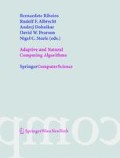Abstract
The paper introduces a new type of ontogenic neural networks called Interval Basis Neural Networks (IBNNs). The IBNN configures the whole topology and computes all weights after a priori knowledge collected form training data. The training patterns are grouped together producing intervals separately for all input features for each class after statistical analyses of the training data. This IBNNs feature make possible to computed all network parameters without training. Moreover, the IBNN takes into account the distances between patterns of the same classes and builds the well-approximating model especially on the borders between the classes. Furthermore, the IBNNs are insensitive for quantity differences in patterns representation of classes. The IBNNs always correctly classify training data and very good generalize other data.
Access this chapter
Tax calculation will be finalised at checkout
Purchases are for personal use only
Preview
Unable to display preview. Download preview PDF.
References
Duch, W., Korbicz, J., Rutkowski, L., Tadeusiewicz, R. (eds) (2000) Biocybernetics and biomedical engineering, Neural networks, vol. 6, EXIT, Warsaw.
Duch, W., Jankowski N. (1997) New neural transfer functions, Journal of Applied Mathematics and Computer Science, 7(3): 639–658.
Fiesler, E., Beale, R. (eds) (1997) Handbook of neural computation, IOP Publishing Ltd and Oxford University Press, Bristol & New York.
Horzyk, A., Tadeusiewicz, R., (2004) Self-Optimizing Neural Networks, Advances in Neural Networks — ISNN 2004, Proc. of International Symposium on Neural Networks, Dalian, China, Springer-Verlag, Berlin-Heidelberg, pp. 150–155.
Horzyk, A. (2003) Introduction to Self-Optimising Neural Networks for Classification Tasks, Advanced Computer Systems, Sołdek J., Drobiazbiewicz L. (eds), Szczecin, INFORMA, pp.127–135.
Lowe, D. (1989) Adaptive radial basis function nonlinearities and the problem of generalization, 1st IEEE International Conference on Artificial Neural Networks, London, UK, pp. 171–175.
Specht, D. F. (1990) Probabilistic neural networks. Neural Networks, 3: 109–118.
Tadeusiewicz, R., Mikrut, Z., (1998) Neural-Based Object Recognition Support-From Classical Preprocessing to Space-Variant Sensing. Invited paper. In M. Heiss (ed.): Proceedings of the International ICSC/IFAC Symposium on Neural Computation NC ’98, Vienna University of Technology, ICSC Academic Press, Canada/Switzerland, pp. 463–468.
Author information
Authors and Affiliations
Editor information
Editors and Affiliations
Rights and permissions
Copyright information
© 2005 Springer-Verlag/Wien
About this paper
Cite this paper
Horzyk, A. (2005). Interval Basis Neural Networks. In: Ribeiro, B., Albrecht, R.F., Dobnikar, A., Pearson, D.W., Steele, N.C. (eds) Adaptive and Natural Computing Algorithms. Springer, Vienna. https://doi.org/10.1007/3-211-27389-1_13
Download citation
DOI: https://doi.org/10.1007/3-211-27389-1_13
Publisher Name: Springer, Vienna
Print ISBN: 978-3-211-24934-5
Online ISBN: 978-3-211-27389-0
eBook Packages: Computer ScienceComputer Science (R0)

